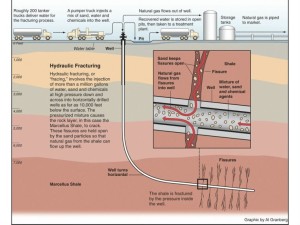Blog Archives
Shale Gas
Shale is a type of sedimentary rock that contains clay and minerals such as quartz. It is commonly found in rocks from the Paleozoic and Mesozoic Eras, meaning that it is often between 500 and 700 million years old. Shales are known to be rich in organic matter, including natural gas.
Shale gas refers to natural gas mined from shale wells. A form of gas-rich rock, shale is often found in layers in the ground. Though extracting gas from shale has not been very profitable in the past, recent technological breakthroughs have improved the prospects of shale gasmining. In particular, the techniques of hydraulic fracturing and horizontal drilling have largely solved some of the problems associated with gaining access to shale gas. Some have criticized shale gas mining as harmful to the environment, however.
Although shale gas wells are typically not permeable enough to allow for easy extraction of natural gas, the advent of hydraulic fracturing has helped circumvent this problem. Hydraulic fracturing involves drilling a borehole into a well and pumping in a fluid called a fracture fluid. The fracture fluid serves to increase the pressure in a well, leading to the formation of new fractures. A permeable mix such as sand can be added to keep the fractures open and allow natural gas to flow out of the well. Hydraulic fracturing techniques have opened up many 
shale gas wells as potential sources of natural gas.
Another technology that has made shale gas extraction more economical is horizontal drilling. Horizontal drilling seeks to modify the path of a borehole to better penetrate a gas-rich shale. This technique is used because shale wells often stretch horizontally in layers that are not very thick in the vertical direction. To maximize the flow of natural gas, however, the surface area of the well in contact with the borehole must be maximized. Hence,boreholes are drilled horizontally through a shale well to improve the flow of gas.